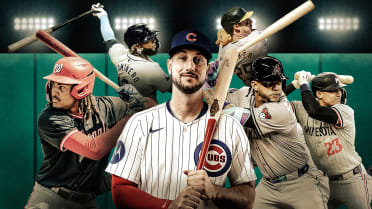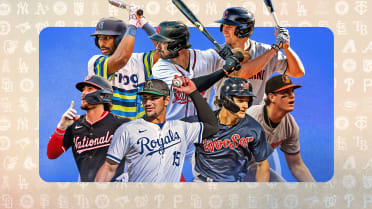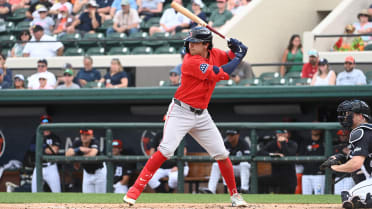The 5 keys to becoming a Major League umpire

The prospects flocked to Florida, equipped with natural ability, a desire to get better and a dream to go pro. They are, perhaps, the future of Major League Baseball, should the lessons being imparted by their instructors take root and their Minor League careers flourish.
These are not promising young players; they are aspiring young umpires -- attendees of MLB’s first Umpire Prospect Development Camp in Vero Beach, Fla.
A major shift is taking place in the professional umpiring world, from the way potential umps are trained to the roster of umps at the Major League level. When MLB announced Thursday the appointment of an unusually large rookie class of umpires for 2023, it was notable that four of the 10 new hires were products of MLB Umpire Camps -- the events that now serve as a precursor to the newly created Umpire Prospect Development Camp.
MLB has taken a more hands-on approach in the way professional umpires are primed and prepared. The invite-only, four-week camp currently taking place in Vero Beach is the biggest step in that direction.
“It’s the lifeblood of the [umpire] system,” said Michael Hill, MLB’s senior vice president of on-field operations. “That’s why we pushed for this camp. We have our instructors teaching how we want to develop our umpires and how we want them to move on the field. So we’re essentially controlling the process from cradle to retirement.”
The role is becoming more diverse, too.
Those four Umpire Camp alums promoted to the Majors for 2023 -- Adam Beck, Nestor Ceja, Malachi Moore and Edwin Moscoso -- had attended the camps at the Urban Youth Academy in Compton, Calif. Adrian Johnson and Alan Porter -- two veteran MLB umps promoted to crew chief this year -- are the second and third Black crew chiefs ever. Meanwhile, two women -- Jen Pawol and Isabella Robb -- umpired in the Minor Leagues last year, and Pawol could be on the doorstep to MLB at Triple-A this year. And of the 52 prospects in the Vero Beach camp, 24 come from diverse backgrounds.
“That speaks to what we’re trying to do in all aspects of the game,” said Hill, “and that’s to have our workforce better reflect our communities.”
So what, exactly, is the modern process of becoming an MLB ump, and how did the 10 new big league hires -- Erich Bacchus, Beck, Ceja, Shane Livensparger, Nick Mahrley, Brennan Miller, Moore, Moscoso, Alex Tosi and Junior Valentine – get the gig?
Let’s go behind the mask to find out.
1. The base-ics
At a minimum, prospective professional umpires must have a high school diploma or G.E.D., 20/20 vision (with or without glasses or contacts), some athletic ability, reasonable body weight, good communication skills, quick reflexes and good coordination.
And of course, there are plenty of amateur umpiring opportunities out there, beginning at the Little League level (where the gripes of parents are a fine precursor to the wrath umpires sometimes face from fans in big-league ballparks).
Looking particularly good in blue or black is not a prerequisite, but it can’t hurt.
2. Camping out
If the above sounds like you -- and you think you are capable of distinguishing whether a 99-mph cutter was in or out of the strike zone -- your next step would be to register for an MLB Umpire Camp.
One free camp per month is scheduled from April through August of this year -- in Cincinnati, Chicago, Houston, San Bernardino, Calif., and Norfolk, Va. Standouts from the camps can earn an all-expenses-paid invite to the Umpire Prospect Development Camp for further vetting by professional staff.
MLB also evaluates potential candidates from the Wendelstedt Umpire School in the Daytona Beach, Fla., area. But the newly created camp in Vero Beach is the in-house avenue to professional employment, aligned with MLB’s recent takeover of Minor League operations.
“We have our 52 [current camp participants] that we can evaluate and use to fill vacancies that we have throughout the Minor Leagues,” Hill said.
3. Making the grade
Once in the Minor League ranks, umpires are evaluated by MLB much the way prospects are evaluated by their clubs.
“If there’s a deficiency in any area, it’s going to impact the game,” Hill said. “If you’re deficient in calling balls and strikes, you’re going to notice it. If you’re missing calls on the field, you’re going to notice. All aspects are equally valuable and valued from an evaluation standpoint, because every aspect impacts the game. We want to be thorough in how we evaluate umpires and make sure [we are] as complete as we can be.”
A group of former Major League umpires -- headed by director of umpire development Rich Rieker -- serve as supervisors. MLB is also in the process of working on a more precise means of evaluating umpire strike-zone judgments at the Minor League level.
“[The supervisors] know what it takes to do the job, and they evaluate accordingly,” Hill said. “That process is one where we feel confident that, whenever we have an opening, we’ve done a thorough job of evaluating and the evaluation process is yearlong.”
Though all big league call-up umps come from Triple-A, MLB’s new umpire development system allows the best-performing umps the potential to skip Minor League levels -- a process that aligns more closely with the player development process.
4. Moving “ump” the ranks
When injuries or scheduling issues arise at the Major League level, the best umpires from the Triple-A ranks are given temporary opportunities to break into the big leagues.
This is an important stepping stone toward getting a full-time job, as evidenced by the 10 new big league hires all having previously worked anywhere from 156 to 382 Major League games.
“They have experience and exposure to the big leagues, and we have experience and exposure to them,” Hill said. “We’re able to evaluate them in a big league setting, albeit temporary. They’ve also always gone through the Arizona Fall League, as well, for some extra additional seasoning.”
A silver lining to the COVID-19 season in 2020 -- during which some veteran umpires opted out for the year and the temporary expansion to 16 postseason teams necessitated the use of more umpires in October -- was that more opportunities arose for prospective umps.
5. Getting the call to make the calls
From there, it’s just a matter of timing. Despite what you might think in a year in which 10 veteran umpires retired, turnover at the big league level is usually pretty low. It can often take around seven to 10 years to advance through the ranks to the Majors.
But those who have proven themselves in the modern pipeline are especially prepared for the modern demands of the job. And this year’s large rookie class aligns particularly well with the implementation of several new rules for 2023 (pitch timer, infield shift limitations, bigger bases), because the members of that class all experienced the rules intimately at the Minor League level.
Hill, former president of baseball operations of the Marlins, didn’t go into this offseason knowing for sure that he’d have 10 umpire jobs to fill -- the most since 1999. He felt confident, though, that the pipeline was prepared to deliver.
“I consider myself fortunate, as a club executive, to have been able to make that call to that young callup to tell him he’s coming to the big leagues,” Hill said. “It’s equally gratifying when you call a new umpire and let them know they are full-time on a Major League staff. It’s very similar in the sense that this is what they’ve been working toward. All that hard work has paid off, and you’ve gotten where you wanted to be.”
Anthony Castrovince has been a reporter for MLB.com since 2004.




